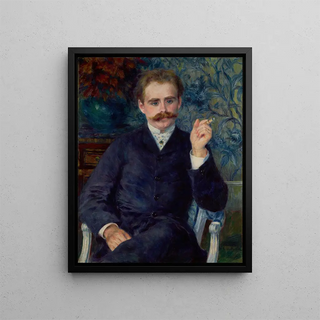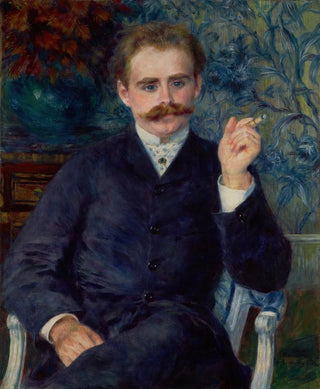Art print | Albert Cahen d'Anvers - Pierre-Auguste Renoir


View from behind

Frame (optional)
Albert Cahen d'Anvers Art print by Pierre-Auguste Renoir – Captivating Introduction
The "Albert Cahen d'Anvers" artwork by Pierre-Auguste Renoir is a true ode to the beauty and elegance of life. Painted in 1879, this iconic canvas captures a fleeting moment, frozen forever in time, where the viewer's gaze is irresistibly drawn to the charm of the model. Renoir, master of impressionism, manages to infuse an atmosphere of light and softness through his delicate brushstrokes and vibrant color palette. This piece is much more than a simple portrait; it embodies the very essence of Renoir's art, blending sensitivity and technique. The art print of this work allows you to immerse yourself in the fascinating world of impressionist art, where every detail tells a story and every shade of color evokes an emotion.
Style and uniqueness of the work
In "Albert Cahen d'Anvers," Renoir's distinctive style is evident in his ability to capture natural light and play with shadows. The model, dressed with refinement, is surrounded by a blurred background that highlights her radiant face and delicate features. The artist uses juxtaposed color strokes, creating a visual dynamic that makes the canvas vibrate. The choice of colors, ranging from pastel shades to more vivid accents, demonstrates Renoir's mastery of chromatic harmony. The serene expression of the model, combined with the softness of the lines, gives the work an atmosphere of tranquility and timeless beauty. This portrait, while rooted in its era, transcends time and continues to inspire admiration among art enthusiasts.
The artist and his influence
Pierre-Auguste Renoir, an emblematic figure of impressionism, knew how to leave his mark on his era with his innovative approach to painting. Influenced by masters such as Monet and Degas, he developed a unique style that emphasizes light and color. Renoir does not merely reproduce reality; he seeks to convey emotions through his works. His influence on modern art is undeniable, inspiring many artists to explore new ways of seeing

Matte finish

View from behind

Frame (optional)
Albert Cahen d'Anvers Art print by Pierre-Auguste Renoir – Captivating Introduction
The "Albert Cahen d'Anvers" artwork by Pierre-Auguste Renoir is a true ode to the beauty and elegance of life. Painted in 1879, this iconic canvas captures a fleeting moment, frozen forever in time, where the viewer's gaze is irresistibly drawn to the charm of the model. Renoir, master of impressionism, manages to infuse an atmosphere of light and softness through his delicate brushstrokes and vibrant color palette. This piece is much more than a simple portrait; it embodies the very essence of Renoir's art, blending sensitivity and technique. The art print of this work allows you to immerse yourself in the fascinating world of impressionist art, where every detail tells a story and every shade of color evokes an emotion.
Style and uniqueness of the work
In "Albert Cahen d'Anvers," Renoir's distinctive style is evident in his ability to capture natural light and play with shadows. The model, dressed with refinement, is surrounded by a blurred background that highlights her radiant face and delicate features. The artist uses juxtaposed color strokes, creating a visual dynamic that makes the canvas vibrate. The choice of colors, ranging from pastel shades to more vivid accents, demonstrates Renoir's mastery of chromatic harmony. The serene expression of the model, combined with the softness of the lines, gives the work an atmosphere of tranquility and timeless beauty. This portrait, while rooted in its era, transcends time and continues to inspire admiration among art enthusiasts.
The artist and his influence
Pierre-Auguste Renoir, an emblematic figure of impressionism, knew how to leave his mark on his era with his innovative approach to painting. Influenced by masters such as Monet and Degas, he developed a unique style that emphasizes light and color. Renoir does not merely reproduce reality; he seeks to convey emotions through his works. His influence on modern art is undeniable, inspiring many artists to explore new ways of seeing






